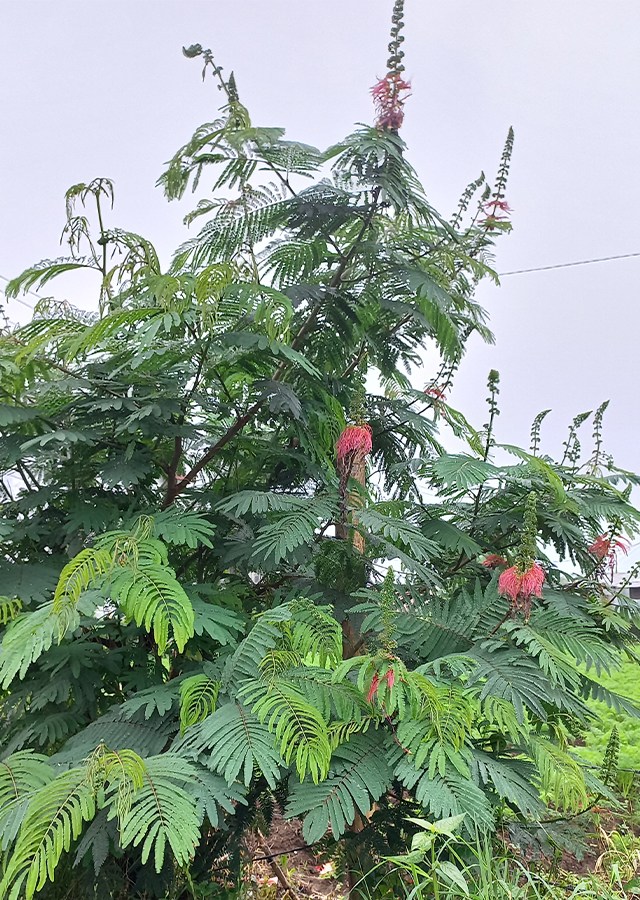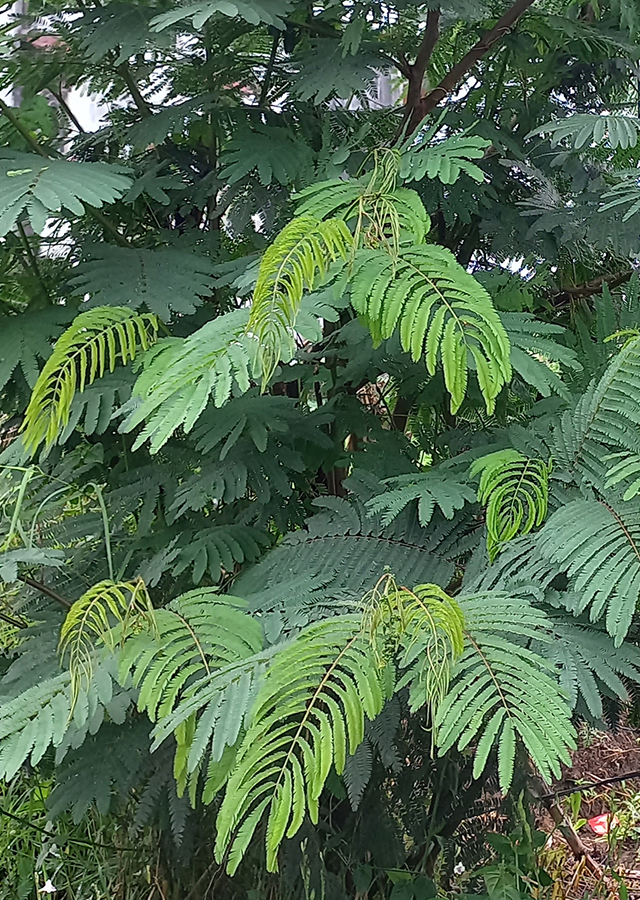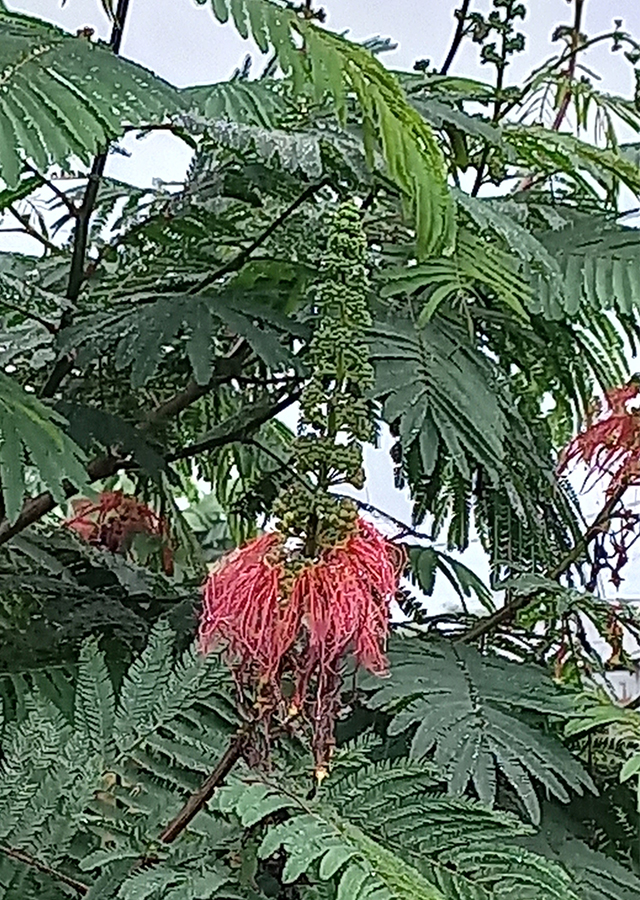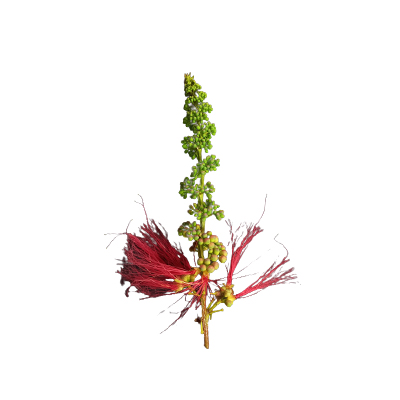Red Calliandra
Calliandra houstoniana var. calothyrsus (Meisn.) Barneby
Fabaceae
Location in our garden
Principal



Synonym
Anneslia calothyrsa (Meisn.) Kleinhoonte
Calliandra calothyrsus Meisn.
Anneslia confusa (Sprague & L.Riley) Britton & Rose
Habitus
Shrubs. A fast-growing, small, thornless shrub, usually growing 5 - 6 m tall but with some specimens in ideal conditions growing up to 12 m
Part Used
Leaves
Bark
Flowers
Growing Requirements
Full Sunshine
Habitat
Riverbanks
Forest
Roadside
Terrestrial
Overview
Calliandra houstoniana var. calothyrsus, native to Central America, has been widely introduced in agroforestry systems in tropical and subtropical regions of the world. It has been introduced in India, Indonesia, Africa, South America, the West Indies, and on several islands in the Pacific Ocean. The plant is often cultivated as a soil improver and companion plant, and is a highly productive fuel wood crop. It is also often grown around houses, the dense foliage providing shade and protection against the rain, whilst its beautiful red 'powder puff' flowers make it an attractive ornamental.
Vernacular Names
Barbe jolote (Mexican), Kaliana (Samoa), Calliandra (Philippines).
Agroecology
A plant of moderate elevations in the humid and subhumid tropics. It can succeed at elevations up to 1,800 metres, but does best at 250 - 800 m. It grows best in areas where annual daytime temperatures are within the range 22 - 30 °C, but can tolerate 18 - 34 °C. It prefers a mean annual rainfall in the range 2,000 - 4,000 mm, but tolerates 700 - 5,000 mm. Prefers a position in full sun. Grows well on a wide range of soil types but prefers light textured, slightly acidic soils. It can tolerate infertile and compacted or poorly aerated soils but does not tolerate waterlogged and alkaline soils. Prefers a pH in the range 5 - 6, tolerating 4.5 - 7.5.
Morphology
- Stems - thornless, often multistemmed.
- Leaves - leafstalks of larger leaves 8-15 cm, their longer interpinnal segments 6-10 (-12) mm; rachis of longer pinnae (4) 5-8.5 cm; longer leaflets linear acute 4-9(-10) × 0.65-1.9 mm, either straight or gently incurved.
- Flowers - inflorescence-axes either glabrous, or puberulent, or pilose, but the peduncles at most thinly so; peduncles (3-)4-12(-15) mm; pedicels 2-4.5 mm; perianth commonly glabrous, rarely micropuberulent; calyx 1.6-2.3 x 2.2-3.2 mm, the teeth 0.25-0.6 mm; corolla (6-)6.5-9.5(-11.5) mm, the lobes as long as tube or separating to rim of stemonozone; androecium 40-52-merous, usually crimson throughout, occasionally pallid proximally and pink distally.
- Pods - 8-11 (-12) × 1.1-1.6 cm, commonly glabrous or micropuberulent, less often strigulose or even pilose.
Cultivation
Propagated by seeds - the seed has a hard coat and requires pre-treatment by scarification. This can be carried out by carefully abrading some of the seed coat (being careful not to damage the embryo) to allow the ingress of water. A simpler method is to immerse the seed in a small amount of almost boiling water (which cools down quickly enough so that it does not kill the seed) and then soak it for 12 - 24 hours in warm water before sowing. Seed germination occurs after 4 days and continues for 21 days with most seed germinating between 10 - 25 days from sowing.
Chemical Constituents
Tocopherol compounds, carotenoids, flavonoids, saponins, tannins, alkaloids, steroids, gallic acid, methyl gallate, myricitrin, quercitrin, myricetin 3-O-â-D4C1-lucopyranoside, afzelin, isoquercitrin, myrecitin 3-O-(6 -O -galloyl)-â-D glucopyranoside, myricitrin 2 -O-gallate, quercitrin 2 -Ogalate, afzelin 2 -Ogalate,1,2,3,4,6-penta-O-galloyl-â-D-4C1 - glucopyranoside, myrictrin 2 , 3 -di-Ogalate, quercetin 3-O-methyl ether, 2-Hydroxy-4-Methoxy benzoic acid, caffeic acid, betulinic acid, digital glycosides, glycosides, fatty acids, polyphenols, anthraquines.
Traditional Medicinal Uses
As a medicine for rheumatism, shortness of breath, uterine cancer, arthritis, and blood purifier as well as contraception. It can also be used as an anthelmintic (worm medicine), antidiarrheal, antispasmodic, antipyretic, anticoligenic, anticonvulsant, analgesic, antiulserogenic, antimicrobial against bacteria Staphylococcus aureus, Escherichia coli and Staphyloccocus gallinallum.
Part Used
Reference Sources
- Cabi. Calliandra houstoniana var. calothyrsus. https://www.cabi.org/isc/datasheet/14011. 19-11-21.
- Fern, Ken. Useful Tropical Plants. (2021). Calliandra houstoniana var. calothyrsus. https://tropical.theferns.info/viewtropical.php?id=Calliandra+calothyrsus. 19-11-21.



